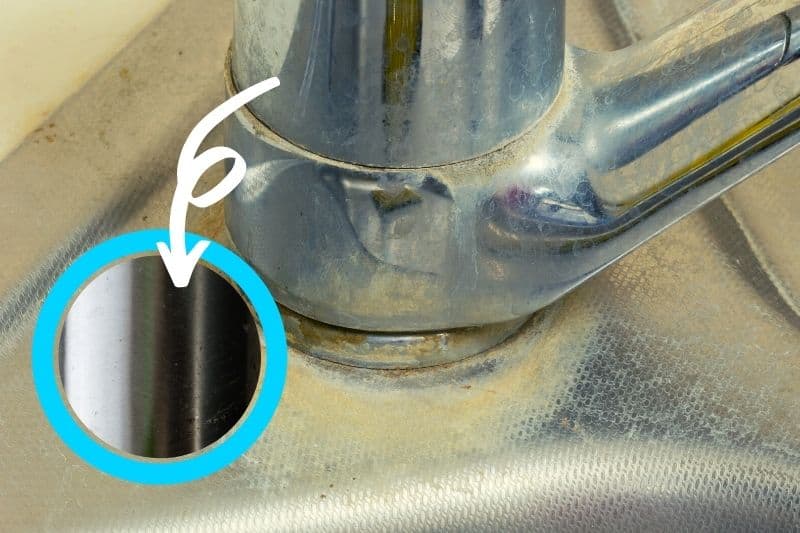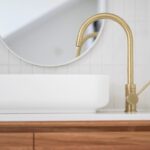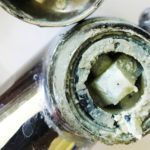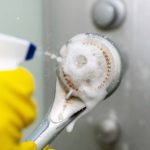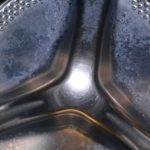Limescale is that nasty looking stuff that can build up anywhere water touches – particularly in hard-water areas. This means it can quickly build up in showerheads, on taps, in dishwashers, washing machines, and just about anywhere else water is allowed to evaporate.
Most people’s motivation to remove limescale is usually because it looks nasty, and in this guide, we’re going to cover how to remove this chalky build-up from taps.
What Is Limescale?
Limescale is the result of a mineral build-up that is left behind when water evaporates from a surface.
Whilst limescale can eventually build up anywhere, it is much more common in areas with hard water, which is water with high mineral content.
As the water evaporates, it leaves behind the minerals, resulting in the white chalky build-up.
Depending on where it builds up, limescale can cause varying degrees of damage. At the lower end of the scale, limescale can cause blockages in taps and showerheads, which can reduce water flow and their efficiency.
Limescale build-up in pipes can cause a similar problem, however, with more serious consequences.
Blocked pipes can prevent the toilet from flushing properly, which can cause a hygiene problem.
Despite limescale being unsightly, it isn’t bad for you in small amounts. It is worth considering, however, that limescale can dry out the skin, so if you live in a hard water area, consider using a moisturising soap.
Before You Start
Before you get your hands dirty, cleaning the limescale off your tap, you need to consider the logistics of keeping your chosen method in place.
Many methods require soaking, and this is especially important if the limescale build-up is at the business end of the tap.
If this is the case, you can put your desired chemical in a plastic bag, put the bag over the end of the tap, and tie the bag off to keep it in place using an elastic band or piece of string.
This same tip applies if you are applying one of these methods to a showerhead.
Methods to Remove Limescale from Taps
Let’s get into these cleaning methods for limescale on your taps, starting with my favourite citrus fruit…
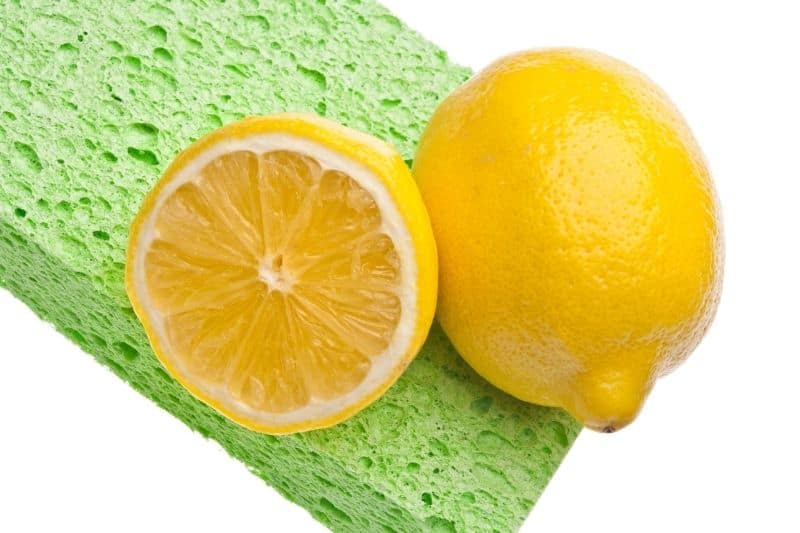
1. Lemon
Lemon’s naturally acidic nature makes it an ideal option for breaking down limescale. Depending on what you have access to, you can either use fresh lemon or bottled lemon juice.
If you are using a fresh lemon, first cut it in half. You can use an older lemon for this if you have one laying around; if the lemon still contains flesh and juice, you’re good to go.
Place half the lemon flesh-side up over the end of the tap and push it up so the tap embeds within the lemon’s flesh. You might need to twist the lemon back and forth a few times.
Once the lemon is in place, cover it with a plastic bag or strong clingfilm, and use an elastic band to tie the bag off if needed to keep the lemon in place.
Leave the lemon in place for a few hours, before checking on progress. If the limescale comes away when you wipe it with a cloth, it’s ready to go.
If the limescale is still solid, reset the lemon and leave it for a few more hours or overnight if needed.
Once you are satisfied that the lemon juice has cut through the limescale, discard the lemon and bag, before wiping the area with a cloth, sponge, or old toothbrush. After finishing cleaning, be sure to rinse the area thoroughly with hot water.
If you need to clean the rest of the tap too, simply squeeze lemon juice over the affected areas, leave it to sit for an hour or so, before wiping away. The limescale on these surfaces of the tap should lift away easily.
If you only have lemon juice, you can remove limescale from the tap in much the same way as above. Simply put lemon juice in the bottom of a plastic bag and tie it around the end of the tap so the faucet sits in the juice.
2. Vinegar
White vinegar is a cleaning favourite, and it is more than up to the job of dealing with limescale.
Mix a solution of one part water and one part white vinegar in a bowl. You need to make up enough solution to saturate the cleaning cloth that you are going to use.
Soak a clean cloth of your choice in the solution, and make sure that it is fully saturated. Scrub the limescale with the saturated cloth for around a minute; this will start loosening up the limescale.
Soak the cloth in the vinegar-water solution again and wrap the cloth tightly around the head of the faucet.
Make sure that the cloth is wound tightly, and that it is sitting flush against areas that have a build-up of limescale. You will need to leave the cloth in place for a few hours if not overnight, so it might be necessary to use an elastic band to hold the cloth in place.
Check on progress after a few hours, and if the limescale is still stuck, resoak the cloth in the vinegar solution and leave it on for longer.
Once the limescale has all been loosened, remove the cloth, and use it to wipe away the deposits.
The limescale should come away easily, and any film left behind should disappear with a little elbow grease. Rinse away any remaining vinegar with clean water, and you’re good to go!
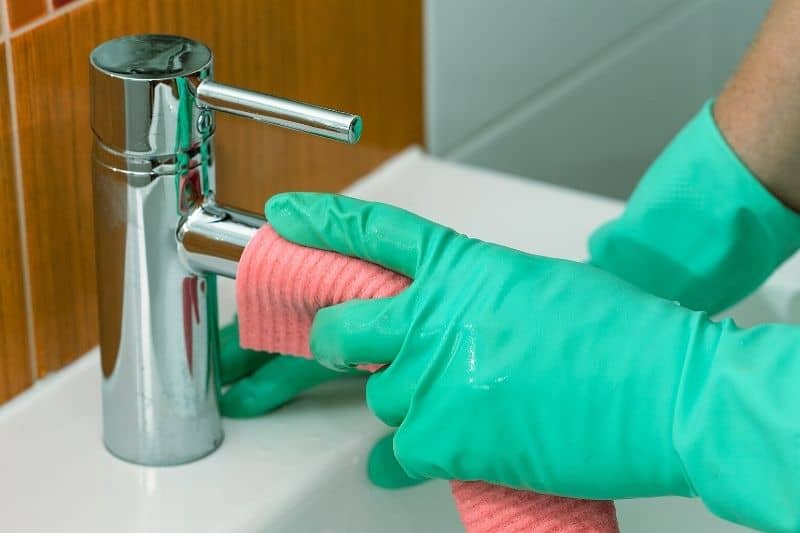
How to Clean Metal-Plated Taps
Some metal-plated taps are delicate, and so acidic or corrosive cleaning methods should be avoided. These taps include those that are plated with nickel, brass, and gold to name but a few. If your taps are plated with one of these metals, or you prefer more gentle cleaning solutions, read on for tips on how to clean these delicate surfaces.
If you aren’t sure if a method is suitable for your tap, conduct a spot test first on an out-of-sight area of the tap to make sure it doesn’t damage or discolour the finish.
1. Wipe Down Daily
One of the best ways to look after these delicate surfaces is to try to avoid limescale build-up entirely.
To do this, keep a dry, clean microfibre cloth close to the sink, and make sure to wipe the tap down to dry it after each use, or at least once a day. Soaking up the excess moisture that has gathered around the tap will reduce the chances of limescale building up.
2. Soapy Water
If limescale has built up already, the problem can sometimes be tackled with hot soapy water. Ideally, you need to use distilled water for this method, as this water will not leave behind mineral deposits.
Add a small amount of a mild washing up liquid to hot distilled water, and simply wipe the area down with a soft cloth. Dry the area completely with another cloth.
Take care with this method to avoid applying too much pressure, as some fixtures can be easily scratched or damaged.
3. Bicarbonate of Soda
Bicarbonate of soda can help tackle small, cloudy hardwater spots. This method however is not suitable for thicker build-ups.
Mix a teaspoon of bicarbonate of soda with a tablespoon of hot distilled water to create a paste.
Moisten the corner of a soft sponge or cloth with this paste, and gently dab each cloudy water spot. Rinse the area thoroughly with clean distilled water, and completely dry the area.
Fix Any Leaks
If you notice your tap dripping a lot or spot any leaks around the base, get this sorted straight away. Allowing water to continually sit or slowly drip will make it much easier for limescale to build up. So keep things as dry as possible around sinks and baths to deter limescale from setting in.

Lover of coffee, painting, and all things cute and fluffy. I’m always on the lookout for easier, more gentle ways to tackle awful household chores.
